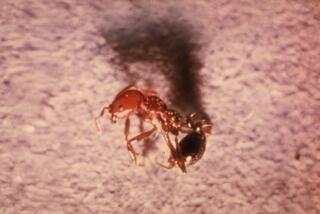Tips on Dealing With Fire Ant Encounters
With the discovery of fire ants in Orange County, here are some safety tips:
* Fire ant sting reactions range from localized itching and swelling to severe, life-threatening anaphylaxis.
* Almost all people stung by fire ants develop an itchy, localized hive at the sting site that usually subsides within 30 to 60 minutes. This is followed by a small blister at the sting within four hours. A sterile sore with pus forms in eight to 24 hours. It then ruptures and crusts in 48 to 72 hours.
* Treatment is aimed at preventing secondary bacterial infection, which may occur if the wound is scratched or broken. Scarring may also occur. Diabetics and others with circulatory disorders, including varicose veins and phlebitis, are at special risk for complications.
* Up to 50% of patients develop large local reactions at the site of fire ant stings. Swelling may last for several days and may be accompanied by itching, redness and pain. Anaphylaxis is a generalized, systemic allergic reaction that may be life-threatening. It usually occurs in people sensitized by a previous sting. It may be manifested by flushing, generalized hives, swelling of the face, eyes or throat, difficulty breathing, or loss of consciousness. Deaths due to anaphylactic reactions to fire ant stings have been documented in patients ranging from 16 months to 65 years.
* Approximately 1%-2% of the population is at risk of an anaphylactic reaction.
Treatments
* Elevate the extremity and apply ice or a cold compress to reduce swelling and relieve pain. Clean the blisters with soap and water to prevent secondary infection. Do not break the blisters.
* Topical steroid ointments and oral antihistamines may relieve the itching reactions.
* Treatment with oral steroids as well as oral antihistamines may be useful in severe cases. Since the swelling is due to allergy and not infection, antibiotics are usually not necessary.
* Seek medical attention if the swelling progresses or if infection is suspected.
* Anaphylactic reactions should be managed as a medical emergency. If stung, persons at risk should immediately self-administer epinephrine, take an antihistamine and report to a physician or emergency room. Medical treatment may include epinephrine, antihistamines and corticosteroids.
* Persons suffering fire ant sting anaphylaxis should be referred to an allergist for skin testing and immunotherapy.
* Probably all children, fire ant allergic individuals and anyone wishing to avoid bites should take precautions: Wear closed-toed shoes, socks and gloves when gardening to avoid stings.
Source: State of California
